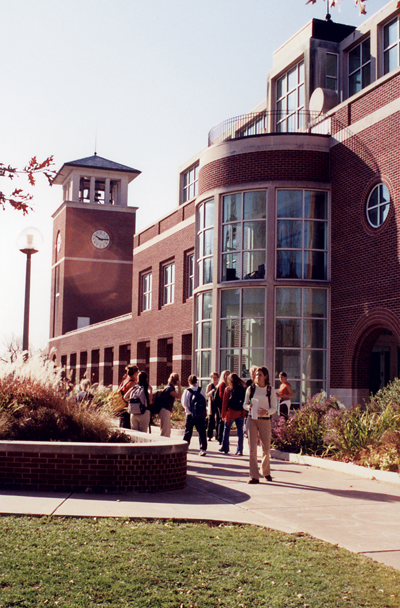Community Profile: Different Generations Generate Economy in Kirksville, Mo.
Photo Gallery | Article
Photo Gallery

Students on campus at Truman State University.

Kirksville, Mo. is making a concerted effort to attract senior citizens through amenities like this fitness center run by the Northeast Regional Medical Center.

Water tower for The Kirksville College of Osteopathic Medicine (KCOM), the nation's first osteopathy school, founded in 1892.
No matter how one defines the word "senior," it is a person whose presence is deeply appreciated in the town of Kirksville, Mo.
In an academic sense, seniors and their fellow students inhabit the campus of Truman State University, the town's largest employer and an institution that has reinvented itself to emphasize high quality. Then there are those seniors, as in senior citizens, for whom Kirksville is placing a renewed emphasis on developing housing and services.
Despite being generations apart and likely holding contrasting views on everything from music to fashion to politics, these two population groups have one thing in common: a strong economic significance in this town of 17,000 residents in the northeastern section of the Show-Me State.
"Moving a Cemetery"
Directionally challenged or not, many Missourians at one time or another have mixed up the regionally named universities in the state's four corners. A bit of that confusion was lifted in 1996 when Northeast Missouri State University in Kirksville changed its name to Truman State University in honor of the state's only native son to become president of the United States. More meaningful than the new name, however, were the reasons the university chose to distinguish itself in such a way.
Ten years earlier, the Missouri General Assembly decided that Northeast would adopt rigorous academic requirements and focus on liberal arts and sciences. The ramifications of this shift in mission have been dramatic. The university has slashed the number of programs it once offered by almost 100 (from 140 to 43), while increasing the number of faculty from 265 to 375. In addition, the academic requirements for incoming freshmen are much tougher now, and the number of students involved in undergraduate research with faculty members is up sevenfold.
University President Jack Magruder says that many of the decisions to comply with the school's new designation were difficult, including eliminating all two-year certificate degrees and divisions such as industrial sciences and home economics.
"Transforming a university is like moving a cemetery," he says. "It's just not an easy thing to do."
Magruder says that resistance to the change came from two groups: alumni who saw their programs disappear and residents who resented tighter state controls on the local university.
"It was a controversial time," agrees Jeff Romine, an accounting professor who has been with the university for 25 years. "Change is always hard. But there is not anyone who would look back now and say that it was the wrong thing to do."
Stricter admission standards and a refocused commitment to fewer areas of study enable Truman to compete with more expensive private universities. Less and less, people are comparing the school to comprehensive public universities that offer open admission, as Truman once did.
This change in focus has paid off, as the university continues to bask in glowing praise from national media. For five straight years, U.S. News and World Report has ranked Truman as the No. 1 public university in the Midwest in the Universities-Master's category. Other accolades have come from Kiplinger's Personal Finance magazine, Money magazine and The New York Times, which in January 2000 called Truman "a small liberal arts version of flagship institutions like the University of California at Berkeley and the University of Michigan. ...Truman State offers small classes and an honors program and continually tests its 6,000 students with national examinations to determine where it needs to improve instruction."
The university clearly has enjoyed a sustained period of momentum, which has led to campus improvements like a new fine arts building, set to open in early 2002, and a new science building, scheduled for completion in late 2004. Nevertheless, as a public institution, Truman is still subject to state budgetary considerations. Magruder says that belt-tightening by the state government resulted in a 5 percent shortfall for fiscal year 2002. Areas that were trimmed as a consequence included travel and visiting scholar programs.
"If we had to deal with these kinds of cuts for a long period of time, it would hurt," Magruder says. "We're competing with very expensive schools with tremendous endowments. We do a lot with a little. Yet, if our resources can't keep pace, then we're in trouble as an institution."
Targeting Older Residents
Sprinkled throughout the Kirksville/Adair County Strategic Plan are references to making the area a more enticing place for senior citizens to live.
"Our senior population will continue to grow at a fast rate due to aging baby boomers especially," says Mari Macomber, the city's economic and community development director. "So, we're going to need to focus services on this segment."
One way to improve in this area is to increase the amount of senior housing and the coordination of services. Vacancy rates at most senior properties in Kirksville are low; some have waiting lists of two to three months. But help is on the way, thanks to The Kirksville College of Osteopathic Medicine (KCOM), the nation's first osteopathy school, founded in 1892.
In September, KCOM broke ground on a senior living campus on 100 acres to the west of the college. The complex will consist of 100 apartments, 20 cottages and a senior wellness and community center providing amenities that include a multipurpose room, computer lab, library and health screening rooms. A handful of KCOM students will also live in the retirement community as part of their training in geriatric medicine, but all students will have the opportunity to work with seniors.
"Often times, our students are studying the disease side of aging," says Elsie Gaber, assistant vice president for community developments at the college. "There is a growing number of people over the age of 65 who are active adults engaged in meaningful activity. This will give students a chance to know the healthy side of aging."
The first phase of the complex is scheduled for completion in 2003. The Missouri Division of Aging has designated the project as one of four "Aging in Place" pilot programs because it will not require senior citizens to leave home to receive services.
Next door to the KCOM campus is the Northeast Regional Medical Center, a hospital whose areas of interest to seniors include a cancer treatment center, a wide range of cardiac services and a health club with special rehabilitation programs for cardiac and pulmonary patients.
Tennessee-based Community Health System, one of the largest operators of nonurban hospitals in the country, purchased Northeast Regional in October 2000. The hospital organized a Senior Circle club last May. Senior Circle, a national organization for people 50 and older sponsored by Community Health System, provides activities like health education classes, bingo and coffee gatherings. The Kirksville chapter consists of about 150 members.
"Participants are able to meet a group of people and get social and emotional support that they may not ordinarily get," says Laura Gruber, coordinator for Senior Circle. Another benefit to senior citizens was the opening of a satellite Veterans Administration clinic in Kirksville three years ago.
"Our veterans in town used to have to travel to Columbia for a monthly medical visit," says Martaun Ownbey, a social service worker with the Missouri Department of Health and Senior Services. "Some of them get to a point where they just can't take a 90-mile trip. Now, they can at least get their monthly medical care here."
Macomber hopes that the attractions of Kirksville will become known to retirees in other cities. She says that in her job as economic development director, she is occasionally asked why someone would want to retire here. She responds that Kirksville's low cost of living, together with the improving senior services and cultural events through Truman, makes the area a viable choice. And for those who face brutal winters in states to the north, Kirksville offers a break.
"Certainly, Kirksville isn't Florida," she says. "But for people who live north of here, our climate is more appealing and doesn't take them that far away from their hometown, where they still have family."
Kirksville, Mo., by the numbers
| Population |
16,988
|
| Labor Force |
12,529
|
| Unemployment Rate |
2.5%
|
| Per Capita Personal Income |
$18,938
|
| Top Employers | |
| Truman State University |
936
|
| Northeast Regional Health System |
700
|
| Kirksville College of Osteopathic Medicine |
417
|
| Hollister Inc. (maker of medical devices) |
408
|
| Adair Foods Co. |
530
|
Views expressed in Regional Economist are not necessarily those of the St. Louis Fed or Federal Reserve System.
For the latest insights from our economists and other St. Louis Fed experts, visit On the Economy and subscribe.
Email Us

